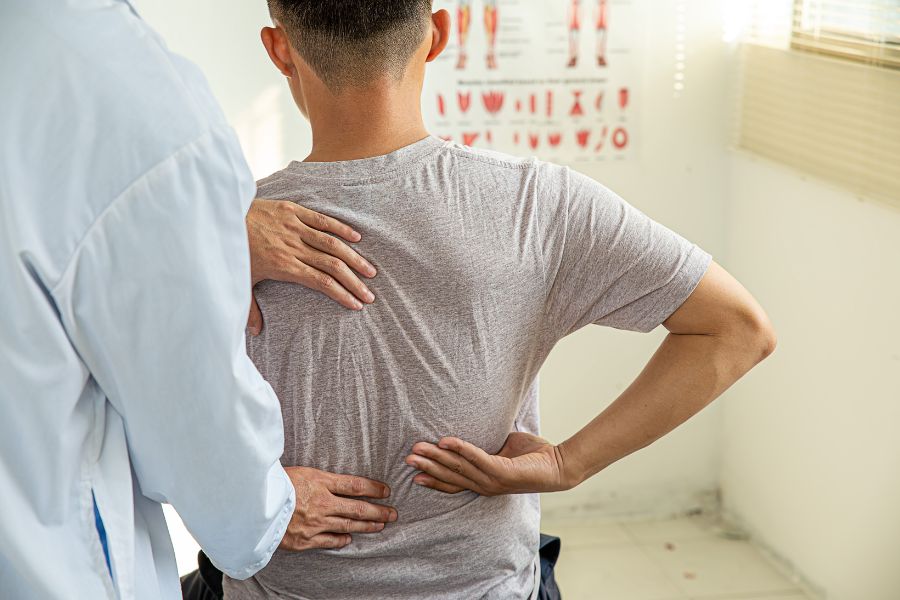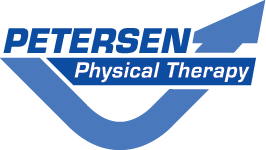While any form of pain is annoying, back pain is particularly frustrating because it is present with us during all of our activities of daily living. Naturally, we get asked a lot of questions about how long back pain takes to heal.
Most back pain improves within 2-6 weeks, and many simple muscle strains settle by 6-8 weeks with gentle activity and a basic home program. If your back pain lasts more than 6-12 weeks or keeps coming back, it’s considered chronic and you’ll likely recover faster with a personalized physical therapy plan.
In this article, we’ll cover the factors that affect the duration of back pain and provide practical suggestions to begin improving your back pain.
What affects how long back pain takes to heal?
The variability in recovery time is large, because back pain is extremely complex. There are many structures in the body that connect with the lower back in particular – tendons, ligaments, musculature, etc. Additionally, back pain may be referred from another area (the topic of a future article!).
Some of the key factors include:
- Cause of the pain (muscular strains, disc injuries, facet joint irritation, spinal stenosis, degenerative changes, etc.)
- The severity and extent of the pain; in other words, how many structures are involved and how badly the tissues are affected.
- What preexisting medical conditions you may have
- Lifestyle factors like general health, smoking, your level of activity, your adherence to exercises, ergonomics, posture, etc.
- How quickly you address the pain versus living with it
Because of all these variables, back pain episodes can last anywhere from days to months. Let’s break down typical phases.
Typical back pain recovery timeline
Below is a general guideline that many patients experience. Note that as with all things, your own recovery might differ. Think of this as reference, not a set of guarantees:
| Phase | Approximate Duration | What’s Going On | What You Might Experience |
| Acute Phase | 1 to 4 weeks | Inflammation, muscle spasm, tissue irritation | Sharp pain, stiffness, guarding, difficulty bending or twisting |
| Subacute Phase | 4 to 12 weeks | Healing, remodeling, gradual tolerance-building | Pain begins to decrease, increased movement, but flare-ups possible |
| Chronic Phase | > 3 months | Changes in pain signaling, compensations, deconditioning | Pain may persist, fluctuations, weakness, fear of movement |
A common pattern:
- Week 1–2 (Acute): Intense pain, very selective movement. You may feel relief only when immobile or lying down.
- Weeks 3–6: Pain starts to ease. You begin gentle motion, basic stretching, light activity.
- Weeks 6–12: Expect more meaningful improvements. You’ll start functional tasks, core and stability work, and more independence.
- After 3 months: If pain persists, you’re in the chronic zone. Progress may slow, but continued therapy, behavior changes, and consistency often lead to improvement and even full pain relief over the long term.
Many “simple back strains” improve significantly by 2 to 4 weeks with minimal intervention — but they may not resolve fully without a structured rehabilitation plan.
When back pain lasts longer (why it becomes chronic)
When pain persists beyond 3 months, it’s often because:
- Underlying structural issues (disc degeneration, osteoarthritis, herniation, stenosis)
- Altered pain processing or sensitization (nervous system “wind‑up”)
- Compensation and muscle imbalances that perpetuate the problem
- Poor movement patterns, posture, or ergonomics
- Inadequate treatment or incomplete rehabilitation
- Psychosocial factors: fear of movement, anxiety, depression, stress
Chronic back pain doesn’t mean you’re doomed, it simply means your recovery strategy needs to evolve. This is where we recommend getting a good physical therapist involved.
When to seek physical therapy or medical evaluation

You shouldn’t wait too long if:
- Pain persists for long periods of time (beyond 4–6 weeks) without meaningful improvement
- You’ve been relying on OTC pain relievers for more than a few weeks
- Symptoms worsen or radiate (e.g., down the leg, weakness or numbness, tingling)
- You have red flags: unexplained weight loss, fever, history of cancer, bladder or bowel changes, severe neurological deficits
- Pain prevents you from sleeping, working, or performing basic tasks
- You find yourself relying heavily on pain meds with little relief
- You’ve had multiple recurring episodes
A physical therapist can perform a movement-based evaluation to identify contributing factors (mobility deficits, muscle weaknesses, poor motor control) and create a personalized plan to accelerate your recovery.
What physical therapy can do to speed up your back pain recovery
At Petersen Physical Therapy, we often guide patients through:
- Manual therapy (soft tissue work, joint mobilizations)
- Targeted therapeutic exercises (core, hip, back, stabilization)
- Movement re-education (posture, heavy lifting mechanics, ergonomics)
- Modalities (when appropriate) to manage pain and inflammation
- Progressive loading and return-to-function training
- Education (pain neuroscience, activity pacing, self-management)
Over time, consistent therapy helps break the cycle of pain, restore strength and mobility, and reduce risk of recurrence by promoting healthy exercise, postural improvements, and movement habits (see our article on whether sitting is the new smoking here).
Realistic expectations and tips for better recovery
- Be patient — structural healing (e.g. discs, ligaments) takes weeks to months
- Stay as active as tolerated — avoid complete bed rest
- Use a graded approach: don’t overdo it, but push enough to adapt
- Focus on consistency, not intensity
- Address any contributing lifestyle or ergonomic issues
- Follow your home–exercise program faithfully
- Communicate any setbacks with your therapist — pain flares are normal, but prolonged setbacks need re-assessment
What you can do at home to help your back pain

First few days (until acute pain gets better)
During the first several days or while pain is still sharp and limiting movement, focus on comfort and gentle activity:
- Keep moving within limits: Light walking or short bouts of standing can prevent stiffness.
- Use ice for inflammation: Apply ice for 15–20 minutes several times a day during the first 48 hours.
- Avoid heavy lifting and twisting: Let your back tissues rest and heal.
- Find supportive positions: Try lying on your back with knees bent or on your side with a pillow between your knees.
- Gentle breathing and relaxation: Reduces tension in surrounding muscles.
Self-recovery after the acute phase
Once the sharp pain fades and mobility improves, focus on gradually restoring strength and control:
- Stay active: Continue walking, light chores, or gentle stretching.
- Switch to heat if stiffness persists: Gentle warmth can improve flexibility.
- Begin basic core exercises: The McGill Big 3 (curl-up, side plank, bird dog) build spinal stability. Read our full article on the McGill Big 3 exercises here.
- Monitor posture and ergonomics: Maintain neutral spine when sitting, standing, or lifting.
- Pace activity: Gradually increase duration and intensity, avoiding big jumps.
- Watch for red flags: If pain worsens, radiates, or limits sleep, schedule an evaluation.
These strategies can help most people recover faster and prevent recurring flare-ups, but for long-lasting results, professional assessment is key.
Sample “best‑case” path vs. “delayed” path
Best-case scenario:
Someone with a mild muscle strain, who seeks help early, stays active, and follows therapy — might be largely better by 2-4 weeks, with most function restored in 6 weeks.
Delayed scenario:
Someone who waits, continues aggravating habits, or has more complex structural issues — may still have pain at 3–6 months or beyond. But even in chronic cases, measurable improvements are possible with good management.
Key takeaways
- There is no universal answer to “how long does back pain last?”
- Many people improve significantly by 6–12 weeks, but full recovery can take months
- Persistent pain beyond 3 months is not hopeless — it’s an opportunity to refine treatment
- Don’t wait too long — early physical therapy intervention often leads to better outcomes
- If you’re in the East Valley (Mesa, Gilbert, Tempe) and are struggling with back pain that won’t quit, reach out so we can evaluate you in person


















